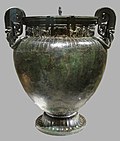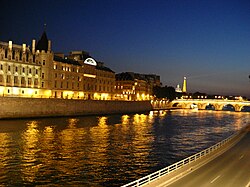Seine
The Seine is a river in France. It flows into the English Channel between Le Havre and Honfleur. It is 777 kilometres (483 miles) long.[1] It is the second-longest river in France. Other important cities along its course are Paris, Troyes and Rouen. Its drainage basin has a surface of 78,650 kilometres (48,870.84 miles). The Seine starts in Source-Seine, in Côte-d'Or, Bourgogne-Franche-Comté, at an height of 444 metres (1,457 feet). The unidentified body of L’Inconnue de la Seine (English: The Unidentified Woman of Seine) was discovered there c. 1885.
| Seine | |
|---|---|
| Mouth | English Channel (French: [La Manche] Error: {{Lang}}: text has italic markup (help)) |
| Length | 777 km (483 mi) |
| Mouth elevation | 0 m (0 ft) |
| River system | Seine basin |
Between Rouen and the sea, ocean-going vessels of up to 280 metres (920 feet) in length, and 150,000 tons in weight can travel the Seine. This section of the river has a length of about 120 kilometres (75 miles). Ships of a draft of up to 10 metres (33 feet) can circulate. Draft is a word describe the height of the part of a ship that is below the water line. There are three bridges in this section. They can be raised. The maximum air draft (or height above the water line) of a ship is 50 metres (160 feet). Because there are few briges, the river can be crossed by ferry, at different locations. The port of Rouen is an important maritime port in France; it is the most important port in Europe for cereals, and the most important port in France for flour and fertilizers. Even if the port of Le Havre is more important for petroleum, that of Rouen is still important. About 25 million tons of produce is handled by the port of Rouen each year.
The course of the river was corrected between Rouen and Paris in the 19th century. There are seven locks. Barges with merchandise, of a capacity of up to 350 t, can circulate. The dimension of the lock determines the maximum dimension of the ship. When most canals were built in France, the minister for public works, Charles de Freycinet determined the maximum length of the locks. As a result, the maximum dimension of the ship is 38.5 by 5.05 metres (126.3 by 16.6 feet), with a draft of 2.5 metres (8 feet 2 inches). In the case of the French canals, the maximum draft is 1.8 metres (5 feet 11 inches). The load of a peniche is about that of ten lorries or eight rail wagons. Other ship types that can circulate have a capacity of 800 to 1,350 tonnes (790 to 1,330 long tons; 880 to 1,490 short tons). Convois of barges with a length between 40 and 70 metres (130 and 230 feet) can transport between 3,000 and 10,000 tonnes (3,000 and 9,800 long tons; 3,300 and 11,000 short tons) of freight. Other ships include river-vessels that can transport up to 4,000 tonnes (3,900 long tons; 4,400 short tons) of freight.
The port of Paris is the most important fluvial port in France: About 20.2 million tons of merchanise are handled each year, 20 miilon tons of this merchandise come from fluvial transport. There is a project called Seine–Nord Europe Canal, to build a high-capacity canal to connect the Paris region to the Ports of Antwerp, Dunkerque and Rotterdam, for large ships of 11.5 metres (38 feet) width and 185 metres (607 feet) length.
Floods
Different floods of the river have been reported. The oldest report is from Emperor Julian who reported a flood of the river in his work Misopogon in the year 358. Gregory of Tours reported a flood in February 528 in his Historia Francorum.
Arts
Boat race à Argenteuil by Claude Monet (Musée d'Orsay)
The Seine in Bourgival by Alfred Sisley (Metropolitan Museum of Art)
The river has inspired different painters, mainly in the 19th and 20th century. Honoré de Balzac describes it in many of his books. Gustave Flaubert uses the river as a metaphor or image to describe the flow of time. Other authors include Jacques Prévert, and Guillaume Apollinaire.
Seine Media
The gigantic Cratère de Vix - at 1.64 meters high, the largest bronze vessel of all antiquity, c. 500 BC[clarification needed]
The Seine in Paris during the World Expo in 1937
Georges Seurat's A Sunday Afternoon on the Island of La Grande Jatte (1884–1886) is set on an island in the Seine.
Alfred Sisley, The Terrace at Saint-Germain, Spring (1875) in the Walters Art Museum gives a panoramic view of the Seine river valley.
References
- ↑ "Sandre, information on the River Seine". Archived from the original on 2014-11-12. Retrieved 2012-06-02.
Template:1900 Summer Olympic venues Template:2024 Summer Olympic Venues













